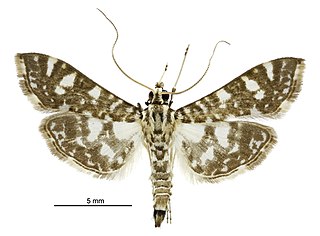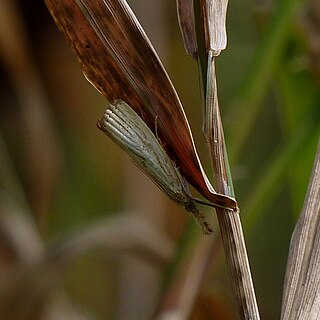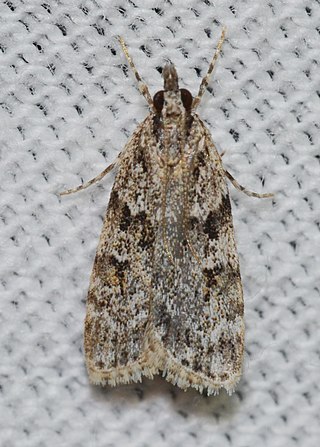
Crambidae comprises the grass moth family of lepidopterans. They are variable in appearance, with the nominal subfamily Crambinae taking up closely folded postures on grass stems where they are inconspicuous, while other subfamilies include brightly coloured and patterned insects that rest in wing-spread attitudes.

The Pyralidae, commonly called pyralid moths, snout moths or grass moths, are a family of Lepidoptera in the ditrysian superfamily Pyraloidea. In many classifications, the grass moths (Crambidae) are included in the Pyralidae as a subfamily, making the combined group one of the largest families in the Lepidoptera. The latest review by Eugene G. Munroe and Maria Alma Solis retain the Crambidae as a full family of Pyraloidea.

Niphograpta is a genus of moths of the family Crambidae. It contains only one species, the water hyacinth moth. It is native to the Amazon basin, but has been introduced in North America, Africa and Australia to control the spread of water hyacinth.

Scoparia is a grass moth genus of subfamily Scopariinae. Some authors have assigned the synonymous taxon Sineudonia to the snout moth family (Pyralidae), where all grass moths were once also included, but this seems to be in error.

Chabulina onychinalis, also known as the swan flower plant moth and until recently called Glyphodes onychinalis, is a moth of the family Crambidae. It is native to the Afro-Asian Region, including India, Sri Lanka, Hong Kong, Thailand, Indonesia, Japan, Australia and New Zealand, and has been recorded in California since 2000.

Fissicrambus mutabilis, the changeable grass-veneer or striped sod webworm, is a moth of the family Crambidae. It is found from Quebec to Florida, west to Texas and Illinois and north to Ontario.

Agriphila vulgivagellus, the vagabond crambus or vagabond sod webworm, is a moth of the family Crambidae. It is found from Quebec and New England to Florida, west to Texas and north to Alberta.

Diastictis ventralis, the white-spotted brown moth, is a species of moth in the family Crambidae. It is found in eastern North America.

Pediasia trisecta, the large sod webworm or greater sod webworm, is a moth of the family Crambidae. It is found in the United States and southern Canada.

Urola nivalis, the snowy urola moth, is a moth of the family Crambidae. It is found from southern Canada and Maine, south to Florida and west to Illinois and Texas.

Pyrausta acrionalis, the mint-loving pyrausta moth, is a moth of the family Crambidae. It is found in eastern North America, including Alabama, Georgia, Massachusetts, Mississippi, New Hampshire, New York, Ontario, Tennessee, West Virginia and Wisconsin.

Aphomia terrenella, the terrenella bee moth, is a moth of the family Pyralidae. It is found in North America from Michigan, Ontario, Quebec and New York south to Georgia.

Galasa nigrinodis, the boxwood leaftier moth or boxwood webworm, is moth of the family Pyralidae. It is found in eastern North America.
Afroscoparia is a genus of moths of the family Crambidae, the grass moths. It was established in 2003 to provide a new name for a Scoparia species, now Afroscoparia contemptalis. At the same time, A. australis was described.

Evergestis rimosalis, commonly known as the cross-striped cabbageworm, is a species of moth in the family Crambidae. It is found in most of the eastern United States.

Palpita gracialis, the gracile palpita moth, is a moth of the family Crambidae. It is found in North America, from California to Texas and Oklahoma.

Scoparia biplagialis, the double-striped scoparia moth, is a moth in the family Crambidae. It was described by Francis Walker in 1866. It is found in North America, where it has been recorded from Alabama, Alaska, Alberta, British Columbia, California, Colorado, Florida, Georgia, Illinois, Indiana, Kentucky, Maine, Manitoba, Maryland, Massachusetts, Michigan, Minnesota, Montana, New Brunswick, New Hampshire, New Jersey, New York, North Carolina, North Dakota, Nova Scotia, Ohio, Ontario, Oregon, Pennsylvania, Quebec, Tennessee, Virginia, Washington, West Virginia and Wisconsin.
Scoparia dominicki is a moth in the family Crambidae. It was described by Eugene G. Munroe in 1972. It is found in North America, where it has been recorded from Florida, North Carolina, Oklahoma, South Carolina and West Virginia.
Scoparia palloralis is a moth in the family Crambidae. It was described by Harrison Gray Dyar Jr. in 1906. It is found in North America, where it has been recorded from British Columbia to southern California, Colorado and western Texas.

Marathyssa basalis, the light marathyssa, is a moth in the family Euteliidae. It is found in North America. The species was first described by Francis Walker in 1865.

















